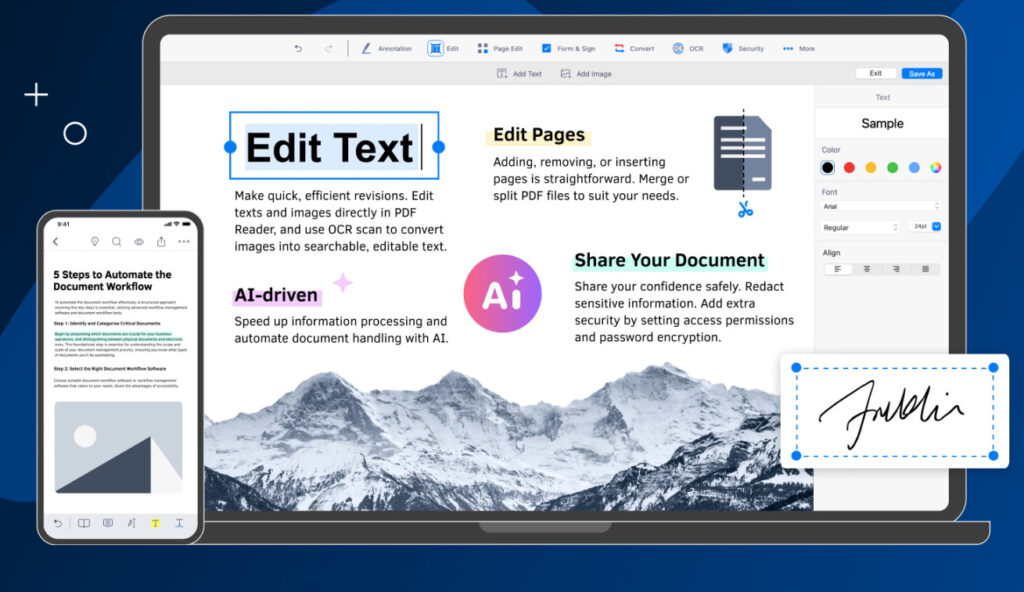Did you know that businesses spend an average of 40% of their work time managing and processing documents manually? This inefficiency not only wastes valuable resources, but also increases the risk of errors and compliance issues.
Enter Intelligent Document Processing (IDP), a revolutionary solution that leverages advanced technologies like AI and machine learning to automate and streamline document management. By transforming how businesses handle documents, IDP boosts efficiency, reduces costs, and enhances data accuracy. Ready to discover how Intelligent Document Processing can revolutionize your business operations? Keep reading to learn more!
What is Intelligent Document Processing (IDP)?
Intelligent Document Processing (IDP) is a technology that uses AI, machine learning, optical character recognition (OCR), and natural language processing (NLP) to automate and enhance the handling of documents.
IDP goes beyond simple automation by incorporating advanced AI and machine learning algorithms to understand and process data. The IDP process begins with document capture, where documents are scanned or uploaded into the system. The images of text are then converted into machine-readable data by OCR. Next, NLP analyzes and understands the content, extracting relevant information and categorizing it appropriately. Finally, machine learning algorithms validate and refine the data, ensuring high accuracy and enabling continuous learning from new data inputs. This streamlined process not only accelerates document handling but also significantly reduces errors and operational costs.
Why You Should Apply Intelligent Document Processing: 5 Benefits of IDP
Implementing Intelligent Document Processing (IDP) offers numerous advantages that can transform your business operations. Here are five key benefits of adopting IDP:
1. Increased Efficiency
IDP automates repetitive and time-consuming tasks, such as data entry and document sorting, which significantly speeds up document processing. This increased efficiency allows employees to focus on higher-value activities, ultimately boosting overall productivity.
2. Error Reduction
By leveraging AI and machine learning, IDP minimizes the risk of human errors in document handling. Accurate data extraction and validation ensure that errors are caught and corrected early, reducing the potential for costly mistakes and improving data integrity.
3. Cost Savings
Automation through IDP reduces the need for manual labor, leading to substantial cost savings. Additionally, the enhanced efficiency and accuracy provided by IDP result in lower operational expenses and a quicker return on investment.
4. Improved Data Accuracy
Thanks to its advanced algorithms, IDP ensures high precision in data extraction and processing. This improved data accuracy not only enhances decision-making but also increases the reliability of business insights and reporting.
5. Enhanced Compliance and Security
IDP helps maintain regulatory compliance by accurately capturing and processing sensitive information. Furthermore, it enhances document security through controlled access and secure data handling practices, protecting your business from compliance breaches and data leaks.
How IDP Revolutionized the Industry: 5 Intelligent Document Processing Use Cases
Intelligent Document Processing (IDP) is making a significant impact across various industries by streamlining operations and improving efficiency. Here are five use cases that highlight how IDP is transforming different sectors; your industry just might be on the list!
(A) Financial Services
In the financial services industry, IDP automates the processing of loans, invoices, and other financial documents. This automation reduces manual effort, accelerates processing times, and enhances accuracy, leading to improved customer satisfaction and reduced operational costs.
(B) Healthcare
IDP is revolutionizing healthcare by efficiently managing patient records, billing, and insurance claims. By automating these processes, healthcare providers can focus more on patient care while ensuring accurate and timely processing of essential documents.
(C) Legal Industry
In the legal industry, IDP assists with contract management, legal research, and case documentation. By automating the extraction and organization of legal documents, IDP helps legal professionals save time and reduce errors, enhancing overall productivity and accuracy.
(D) Government and Public Sector
Government agencies and the public sector benefit from IDP by digitizing records, processing applications, and managing large volumes of documents. This transformation leads to faster service delivery, improved accuracy, and enhanced public trust through transparent and efficient operations.
(E) Supply Chain and Logistics
IDP enhances supply chain and logistics operations by automating the management of inventory records, shipping documentation, and supplier contracts. This automation streamlines workflows, reduces errors, and improves data visibility, ensuring smoother and more efficient supply chain management.

How to Implement Intelligent Document Processing in Your Business
Successfully implementing Intelligent Document Processing (IDP) in your business involves several key steps. Here’s how you can get started:
Step 1: Choosing the Right IDP Solution
Selecting an IDP solution that fits your business needs is the first critical step. Evaluate various options based on features such as AI capabilities, machine learning, Optical Character Recognition, and NLP. Consider solutions like ABBYY FlexiCapture or TotalAgility, which offer comprehensive features and strong vendor support. Ensure the chosen solution can scale with your business and is user-friendly to facilitate easy adoption.
KDAN PDF Reader is also an excellent choice for businesses looking to digitize and streamline their document management processes. Although KDAN PDF Reader does not support NLP functionality yet, this powerful PDF solution offers a comprehensive set of tools for viewing, editing, converting, and signing PDF documents across devices. One of the standout features of KDAN PDF Reader is its ability to convert paper documents into searchable PDFs or editable text files with OCR. This allows businesses to easily digitize their paper-based workflows and make their documents more accessible and searchable.
In addition to its core PDF management capabilities, KDAN PDF Reader has recently integrated AI chatbots. This cutting-edge addition enables users to interact with their documents more intuitively and efficiently, further enhancing the overall productivity and user experience.
KDAN PDF Reader
- Empower your workforce
- Edit, convert, and read PDF documents
- Available on iOS, Android, Mac, and Windows
Enhance your productivity now!
Start NowStep 2: Integration with Existing Systems
Once you have chosen an IDP solution, it’s essential to integrate it with your existing technology stack. This integration ensures a seamless workflow and maximizes the benefits of automation. For example, UiPath Document Understanding offers robust integration capabilities with popular ERP systems like SAP and CRM tools like Salesforce. Smooth integration with your current systems will streamline processes and enhance overall efficiency.
Step 3: Employee Training and Change Management
Effective implementation of IDP also requires thorough employee training and careful change management. Provide comprehensive training sessions to help your staff understand and utilize the new system efficiently. Tools like IBM Datacap often come with extensive training resources and support services. Additionally, manage the transition by addressing employee concerns, promoting the benefits of the new system, and implementing changes gradually. This approach ensures a smooth and effective shift to an automated document processing environment.
Conclusion: The Future of IDP
The future of Intelligent Document Processing (IDP) is bright, with advancements in AI and machine learning promising even greater accuracy, speed, and versatility. As these technologies evolve, IDP systems will become more sophisticated and capable of handling a wider range of document types with minimal human intervention. The growing acceptance of IDP across industries such as finance, healthcare, logistics, and legal services will drive further innovation and integration, making IDP an essential tool for modern businesses.
As we progress, the continuous development of AI and machine learning will unlock new possibilities and applications for IDP, further enhancing its value. Ready to revolutionize your document management with Intelligent Document Processing? Explore the perfect IDP solution for your business, and learn more about IDP today!
# Experience Premium AI FeaturesDownload for Free! KDAN PDF Reader - Mac.Windows
(The featured image is generated by Ideogram.)



 Share Your Experience & Get Rewarded – A Special Thank You from KDAN PDF Reader!
Share Your Experience & Get Rewarded – A Special Thank You from KDAN PDF Reader!